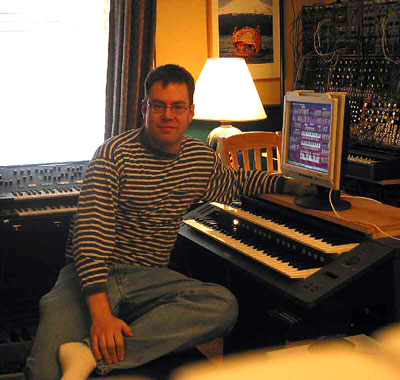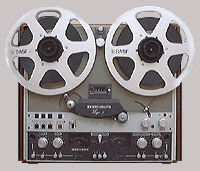
|
|
Frank Vanaman's MidiTzer Music Frank Vanaman at the console of his Mighty MidiTzer. Frank Vanaman is the fifth artist to be featured here at Walnut Hill. We are very proud to feature Frank's Mighty MidiTzer music. Frank is also a member of the Walnut Hill Wall of Fame. To see his Mighty MidiTzer and learn more about him, click here. We quote Frank below: The tunes. I just knocked these together quickly, so they're not note perfect, so don't say you weren't warned! I'd say this is a pretty accurate example of how I usually play- not really polished arrangements, but more of an off-the-cuff style. I'm working with some modifications to the SoundFont, so I'll probably make up another MP3 of different tunes in a short while... I've been having quite a lot of fun with this, I have to admit! 
Frank's Comments on his Mighty MidiTzer musicThis first MP3 is a little over 6MB in size, and runs about 6:42 or so. There are two and a half tunes here: Louise, Frenesi, and (the half-tune) Tiger Rag. The part of the MP3 that has been cut off is the part where the Tiger escapes entirely and goes on an odyssey, searching for some other melody and an entirely non-complimentary harmonic accompaniment. I, ahem, lost hold of the Tiger a little while after it fades out, though some might argue that my grip was loosening a bit earlier on! Soon after that, I simply stopped playing. The Tiger seemed quite relieved! :-D
Not much to say here, except that it took a few false starts to actually record an even remotely decent sounding version of this tune! It's always been a favorite of mine...
An extended version. Possibly one too many choruses, but I thought I'd run through a selection of registrations (which I've noted elsewhere), and I just kept going. There are a few 'vamps' on the Accompaniment until you've got the 'Solo ready' moments, but I think it remains pretty listenable despite that! :-)
Frank Demonstates Mighty MidiTzer RegistrationEveryone, it seems, has their own ideas on registration. At first, I thought, 'oh, I'll have to organize this in a logical manner-- you know: ensembles, use of tibias, color reed combinations and so on.' Suddenly, the whole scheme seemed to take on a huge scope that would render it un-doable. Instead, I decided to perhaps just give a few examples starting with what I've got set in my MidiTzer combination action right at the moment. Basically I'll go through some of my settings, and give an abbreviated explanation of how I use the combination, and maybe discuss a few variations. To hear what they sound like, click on the registation titles. Unlike registering to taste on a 'regular' unit organ, with MidiTzer you always have to remember that there's finite maximum polyphony, and for many of us, it's 64 notes. So, these registrations have been optimized, to some extent, to give an effect I like, while attempting to be economical as well. I almost always run MidiTzer with modern Tibia Unification -on-, which replaces the concert flute voices at 16', 2-2/3', 2' and 1-3/5' on the solo with the tibia. Disclaimer: I don't pretend to be an expert, and I don't pretend to have invented these combinations. What I present here is derived from what I've observed just by either watching or listening to others do their thing. These combinations are not intended to be carved in stone, but are really just examples of what works for me. You might find them useless, though I hope that's not the case. What I do hope is that, if nothing else, they serve as a source of ideas for other registration possibilities. Enjoy!
Viol d'Orchestre 8' Useful for chords and single note melodies. It's fairly incisive, and works well for the main melody of something like "Melody on the Move". An obvious variation would be to turn off the Glock! Add the Celestes (8' and/or 4') for a little more richness. Add the Vox Humana 8' and turn -on- the Main Tremulant for the basis of the brighter Strings/Vox combinations. If the Fifteenth 2' makes it too bright, remove that and add the Piccolo (Tibia 2') with Tibia Tremulant -on- for a smoother variation.
Viol d'Orchestre 8' Vox Humana 8' Piccolo 4' Sort of the basic Tibia/Vox combination, with the addition of the String voice. It's a nice building block for your quiet ballad combinations. Remove the Viol d'Orchestre 8' for smoother sound. For a thicker sound, add the Twelfth 2-2/3 (Tibia). You can use this with the Twelfth added still as a block chord voice. If it seems to be too 'thick' but you like that Twelfth in there, remove the Tibia 8', and add back in the String (and/or the Celeste as well). Adding in the Orchestral Oboe 8' suggests some of the Saxophone-based combinations.
Tibia 16' This has a sort of 'hole-in-the-middle', in that the Tibia 4' is not present. To fill it out a bit, add the Tibia 4' back in. If this is too lush, consider subtracting the Piccolo 2' (Tibia) and using the Fifteenth 2' (Viol) instead, which will brighten things up considerably.
Tuba 8' A 'big-ish' ensemble using, well, not too many voices - with the Sub Octave Coupler on, it should use 9 notes of polyphony for every key you play (assuming that, since the Viol d'Orchestre 8' is on, the Sub Octave Coupler acting on the Viol d'Orchestre 4' should be redundant). For a more brilliant sound, take off the Viol d'Orchestre 4', and add the Fifteenth 2' in its place, giving:
Tuba 8' While it looks wacky on paper, this setup gives a pretty big ensemble. If you are more particular about adding and removing specific components of this, consider that this is functionally equivalent to:
Tuba 16' which should use the same resources. The difference with the latter arrangement is that you can subtract individual components out. For example, you can lighten the ensemble a bit by removing the Tuba 8', and leaving the Tuba 16' in place.
Viol d'Orchestre 8' Viol Celeste 8' Vox Humana 8' Twelfth 2-2/3' Solo Sub Octave Coupler It looks a bit odd, but can sound nice. It may sound odd using the standard "corg_109" soundfont. It does work quite well with the soundfont that I've modified, which uses the Viola and Celeste instead of the Viol d'Orchestre and Celeste. The Sub Octave Coupler essentially allows the Strings, Orchestral Oboe and Vox Humana to also play at 16', while the Tibia plays at 5-1/3'and 2-2/3'. I like this combination better if it doesn't include the 2-2/3, but does include the 5-1/3. With the unification on Miditzer, however, there's no way to do that. So, you might like it better without the 2-2/3.
Vox Humana 8'
Tibia 16' One of the somewhat standard orch. oboe combinations. It works best as a single note melody line, though I think I've used this in chords at least for a half-chorus in one of my MP3 tunes up at Walnut Hill.
Tuba 8' It looks strange written down, and sounds strange too! I use the Sub Octave Coupler and Unison Off merely to bring that lower midrange region up to the middle of the keyboard. This one is definitely best used in moderation (some might argue that 'never' would be better!), and gets messy if used in chords. It works well for things like the melody from Stairway to the Stars.
Post Horn 8'
Tibia 8'
Tuba 8' To thicken it up add the Tibia 8', or the Diapason 8'. Experiment by adding the Diapason 8', having the Main Tremulant -on- or -off-
(a)
Diapason 8' (b) A similar variation to this is:
Tibia 8' Useful with block chords played in the lower midrange of the manual. For a lusher sound, add the Piccolo 4' (Tibia). 
More music from Frank's Mighty MidiTzerHere are two more MP3s, some comments on the tunes, and some comments on the registrations. Oh, and some comments on the new SoundFont! Whew. :-) Hope you like 'em! Like before, these aren't note-perfect, and they were recorded when I was in a bit of a hurry, in a single whirlwind-speed take. I've been sound-font-fiddling, and the instrument you'll hear here is a combination of Bruce Miles' and John Tay's voices. It's still in development, but I thought it was coming along well enough to warrant a tune or two...
File size: 4.32MB, bit rate: 128KB/sec., playing time: 04:36 There are three tunes wrapped up in here: You'll Never Know, with a chorus of I Don't Know Why squeezed in, and Tain't No Use.
Once again, I've been working with the SoundFonts, and this one is a hybrid of Bruce Miles' work and John Tay's. The mysterious vibraphone, which appears here and
in the Tain't No Use resembles a Sidney Torch arrangement with some Jazz-ish variations, though not quite as nicely executed as Torch would have done, I'm sure.
File size: 2.92MB, bit rate: 128KB/sec., playing time: 03:07
This was originally supposed to be a sort of deconstructed version of
Don't worry, it's just a phase I'm going through! The traditional way of doing that Accompanimental effect (the Flutes and Vox playing continuously, with the Vibraphone adding the accents on '2' and '4') usually uses the wood bar Harp and not the Vibraphone, but since I was on a roll with A note about the SoundFont used in these two MP3s: This font uses some of the real pipe samples made by John Tay in combination with some of the voices of Bruce Miles' older '109' SoundFont, all of which have been remapped to the '110' sound font patch arrangement so as to work with MidiTzer 0.40. Since John's samples come from actual pipe work, there is some note-to-note variation in tone color, and some listeners might notice some slightly different sounding Voxes, or a bit more buzz in some of the Orchestral Oboe notes. While some folks might think it best to smooth out the voices for tonal consistency, I think these slight variations add much to the overall realism of the SoundFont. About some of these registrations: As always, my registrations change over time. If you look at my tutorial, you'll see one setting for that 'Sidney Torch Clarinet', and many might assume that's what I used here, except that this version uses the 8' Open Diapason instead of the 8' Tibia. My 'Old' Version:
Tibia 8' What I'm using here:
Open Diapason 8' The "Post Horn" here is also more than just the english horn by itself:
English Horn 8'
Near the end of
Orchestral Oboe 8' |